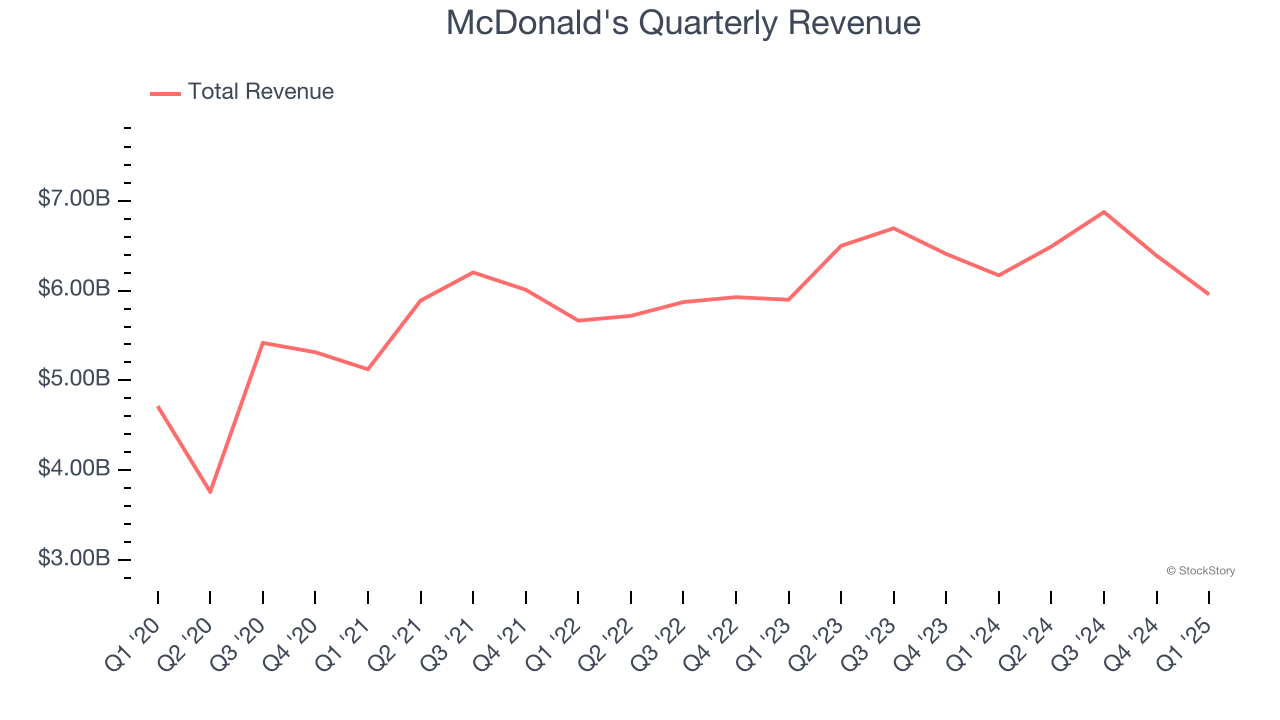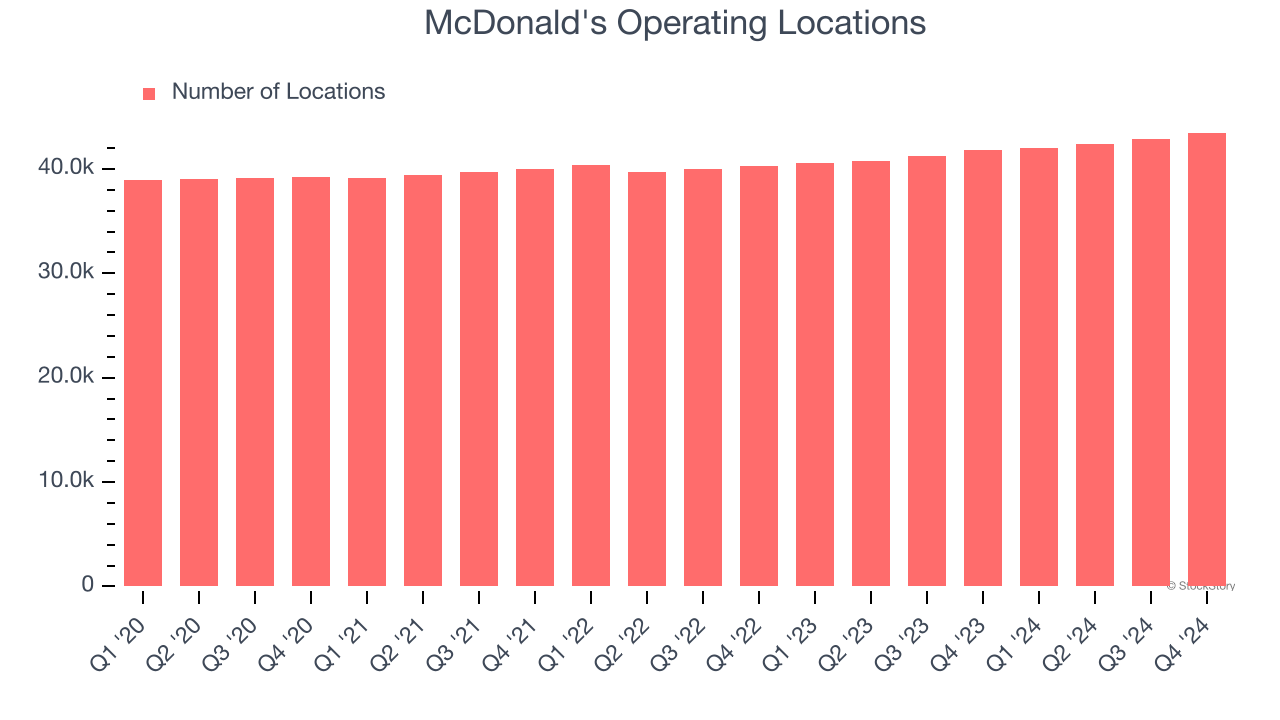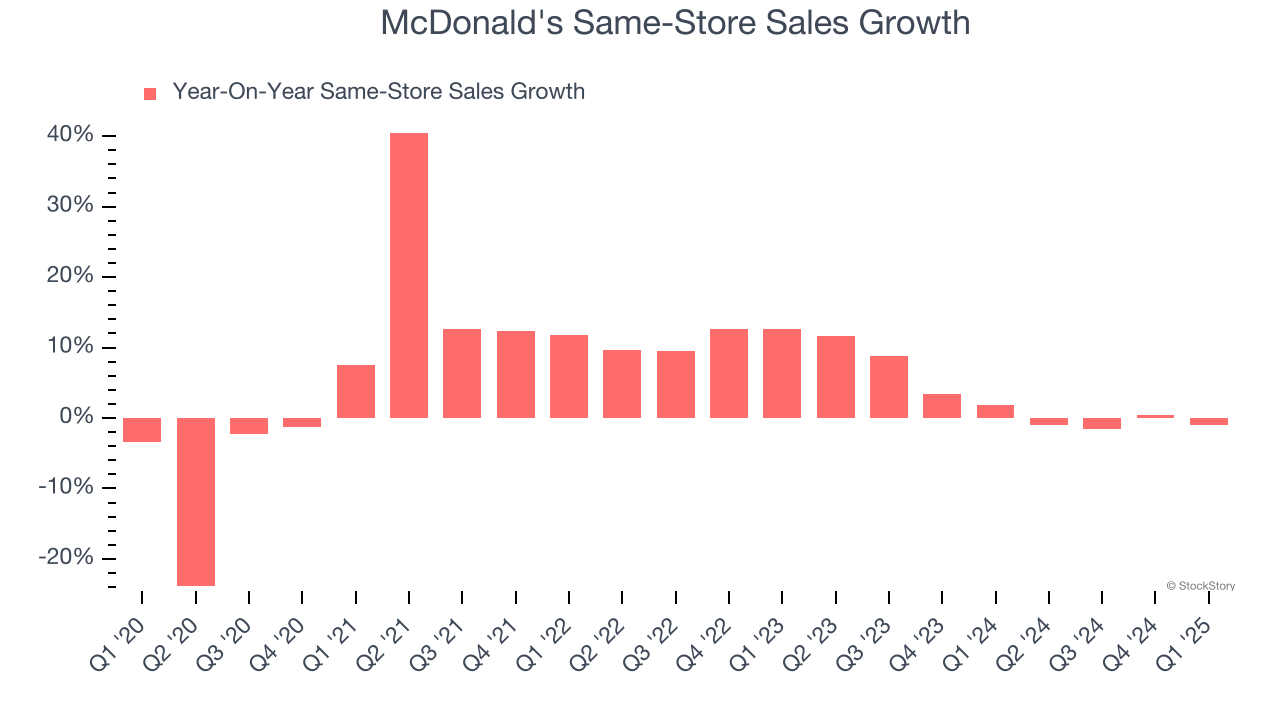
Fast-food chain McDonald’s (NYSE:MCD) fell short of the market’s revenue expectations in Q1 CY2025, with sales falling 3.5% year on year to $5.96 billion. Its non-GAAP profit of $2.67 per share was in line with analysts’ consensus estimates.
Is now the time to buy McDonald's? Find out by accessing our full research report, it’s free.
McDonald's (MCD) Q1 CY2025 Highlights:
- Revenue: $5.96 billion vs analyst estimates of $6.12 billion (3.5% year-on-year decline, 2.7% miss)
- Adjusted EPS: $2.67 vs analyst estimates of $2.67 (in line)
- Adjusted EBITDA: $2.76 billion vs analyst estimates of $3.28 billion (46.3% margin, 15.9% miss)
- Operating Margin: 44.5%, in line with the same quarter last year
- Same-Store Sales fell 1% year on year (1.9% in the same quarter last year)
- Market Capitalization: $228.6 billion
"McDonald's has a 70-year legacy of innovation, leadership, and proven agility, all of which give us confidence in our ability to navigate even the toughest of market conditions and gain market share," said Chairman and CEO Chris Kempczinski.
Company Overview
With nicknames spanning Mickey D's in the U.S. to Makku in Japan, McDonald’s (NYSE:MCD) is a fast-food behemoth known for its convenience and broken ice cream machines.
Sales Growth
A company’s long-term performance is an indicator of its overall quality. Any business can put up a good quarter or two, but many enduring ones grow for years.
With $25.71 billion in revenue over the past 12 months, McDonald's is one of the most widely recognized restaurant chains and benefits from customer loyalty, a luxury many don’t have. Its scale also gives it negotiating leverage with suppliers, enabling it to source its ingredients at a lower cost. However, its scale is a double-edged sword because there are only a finite of number places to build restaurants, making it harder to find incremental growth. To accelerate system-wide sales, McDonald's likely needs to optimize its pricing or lean into new chains and international expansion.
As you can see below, McDonald's grew its sales at a sluggish 3.5% compounded annual growth rate over the last six years (we compare to 2019 to normalize for COVID-19 impacts), but to its credit, it opened new restaurants and increased sales at existing, established dining locations.

This quarter, McDonald's missed Wall Street’s estimates and reported a rather uninspiring 3.5% year-on-year revenue decline, generating $5.96 billion of revenue.
Looking ahead, sell-side analysts expect revenue to grow 4.3% over the next 12 months, similar to its six-year rate. This projection is underwhelming and suggests its newer menu offerings will not accelerate its top-line performance yet. At least the company is tracking well in other measures of financial health.
Here at StockStory, we certainly understand the potential of thematic investing. Diverse winners from Microsoft (MSFT) to Alphabet (GOOG), Coca-Cola (KO) to Monster Beverage (MNST) could all have been identified as promising growth stories with a megatrend driving the growth. So, in that spirit, we’ve identified a relatively under-the-radar profitable growth stock benefiting from the rise of AI, available to you FREE via this link.
Restaurant Performance
Number of Restaurants
A restaurant chain’s total number of dining locations influences how much it can sell and how quickly revenue can grow.
Over the last two years, McDonald's opened new restaurants at a rapid clip by averaging 3.6% annual growth, among the fastest in the restaurant sector. Additionally, one dynamic making expansion more seamless is the company’s franchise model, where franchisees are primarily responsible for opening new restaurants while McDonald's provides support.
When a chain opens new restaurants, it usually means it’s investing for growth because there’s healthy demand for its meals and there are markets where its concepts have few or no locations.
Note that McDonald's reports its restaurant count intermittently, so some data points are missing in the chart below.

Same-Store Sales
The change in a company's restaurant base only tells one side of the story. The other is the performance of its existing locations, which informs management teams whether they should expand or downsize their physical footprints. Same-store sales gives us insight into this topic because it measures organic growth at restaurants open for at least a year.
McDonald’s demand has been healthy for a restaurant chain over the last two years. On average, the company has grown its same-store sales by a robust 2.8% per year. This performance suggests its rollout of new restaurants could be beneficial for shareholders. When a chain has demand, more locations should help it reach more customers and boost revenue growth.

In the latest quarter, McDonald’s same-store sales fell by 1% year on year. This decline was a reversal from its historical levels. A one quarter hiccup shouldn’t deter you from investing in a business, and we’ll be monitoring the company to see how things progress.
Key Takeaways from McDonald’s Q1 Results
Same-store sales fell and missed expectations, leading to a revenue miss. EPS managed to meet expectations, but still, this wasn't a good quarter. The stock remained flat at $316.95 immediately after reporting.
McDonald's underperformed this quarter, but does that create an opportunity to invest right now? If you’re making that decision, you should consider the bigger picture of valuation, business qualities, as well as the latest earnings. We cover that in our actionable full research report which you can read here, it’s free.
